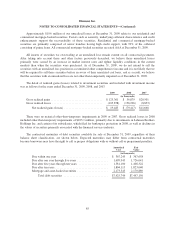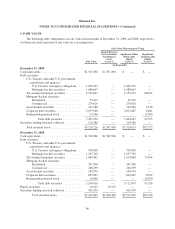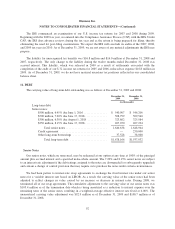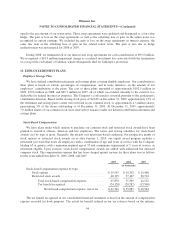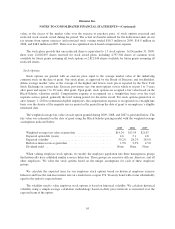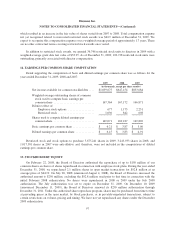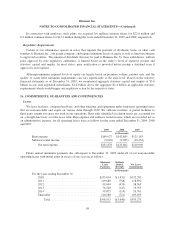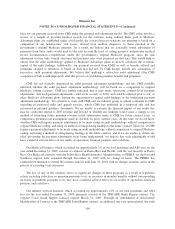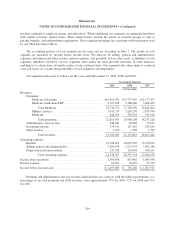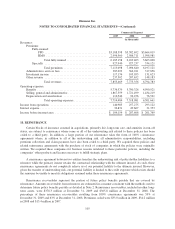Humana 2009 Annual Report Download - page 105
Download and view the complete annual report
Please find page 105 of the 2009 Humana annual report below. You can navigate through the pages in the report by either clicking on the pages listed below, or by using the keyword search tool below to find specific information within the annual report.
Humana Inc.
NOTES TO CONSOLIDATED FINANCIAL STATEMENTS—(Continued)
value, or the excess of the market value over the exercise or purchase price, of stock options exercised and
restricted stock awards vested during the period. The actual tax benefit realized for the deductions taken on our
tax returns from option exercises and restricted stock vesting totaled $16.3 million in 2009, $16.9 million in
2008, and $48.0 million in 2007. There was no capitalized stock-based compensation expense.
The stock plans provide that one restricted share is equivalent to 1.7 stock options. At December 31, 2009,
there were 12,818,855 shares reserved for stock award plans, including 4,797,304 shares of common stock
available for future grants assuming all stock options or 2,821,944 shares available for future grants assuming all
restricted shares.
Stock Options
Stock options are granted with an exercise price equal to the average market value of the underlying
common stock on the date of grant. Our stock plans, as approved by the Board of Directors and stockholders,
define average market value as the average of the highest and lowest stock prices reported by the New York
Stock Exchange on a given date. Exercise provisions vary, but most options vest in whole or in part 1 to 3 years
after grant and expire 7 to 10 years after grant. Upon grant, stock options are assigned a fair value based on the
Black-Scholes valuation model. Compensation expense is recognized on a straight-line basis over the total
requisite service period, generally the total vesting period, for the entire award. For stock options granted on or
after January 1, 2010 to retirement eligible employees, the compensation expense is recognized on a straight-line
basis over the shorter of the requisite service period or the period from the date of grant to an employee’s eligible
retirement date.
The weighted-average fair value of each option granted during 2009, 2008, and 2007 is provided below. The
fair value was estimated on the date of grant using the Black-Scholes pricing model with the weighted-average
assumptions indicated below:
2009 2008 2007
Weighted-average fair value at grant date ........................ $14.24 $17.95 $21.07
Expected option life (years) ................................... 4.6 5.1 4.8
Expected volatility .......................................... 39.2% 28.2% 28.9%
Risk-free interest rate at grant date ............................. 1.9% 2.9% 4.5%
Dividend yield ............................................. None None None
When valuing employee stock options, we stratify the employee population into three homogenous groups
that historically have exhibited similar exercise behaviors. These groups are executive officers, directors, and all
other employees. We value the stock options based on the unique assumptions for each of these employee
groups.
We calculate the expected term for our employee stock options based on historical employee exercise
behavior and base the risk-free interest rate on a traded zero-coupon U.S. Treasury bond with a term substantially
equal to the option’s expected term.
The volatility used to value employee stock options is based on historical volatility. We calculate historical
volatility using a simple-average calculation methodology based on daily price intervals as measured over the
expected term of the option.
95


